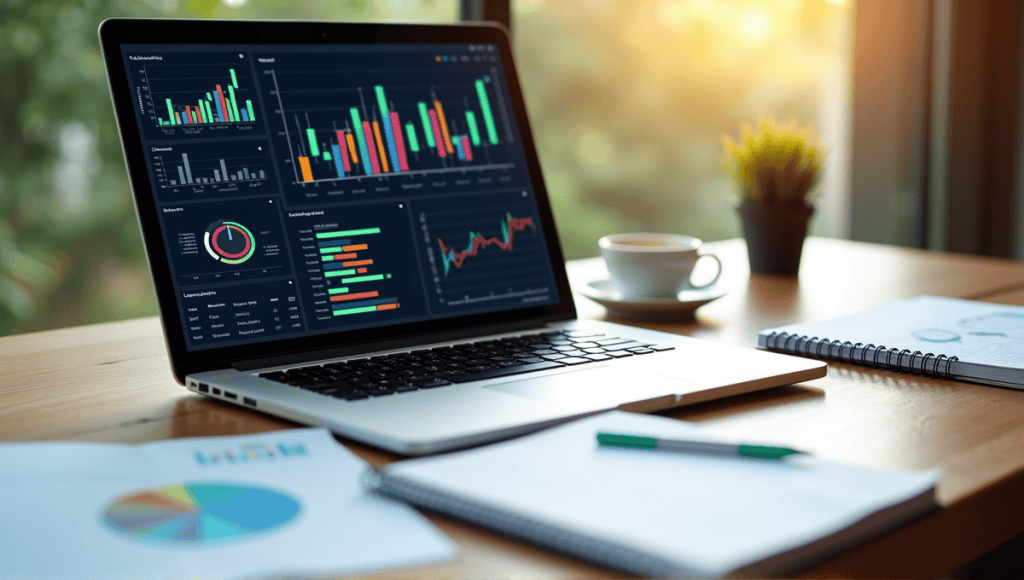As a former industrial engineer turned lean management expert, I’ve experienced the impact trend analysis can have on businesses. It’s not just about the data. Trend analysis is a key strategy to forecast market changes, maximize operations, and ensure you make data driven decisions. In this post, I’ll discuss actionable tips on how trend analysis can take your business to the next level from my 20+ years in the industry.
Understanding Trend Analysis

Trend analysis is a very powerful concept. It allows businesses to look at data over time and identify patterns. You can then use this information to make more informed decisions about the future of your business.
So, what exactly is trend analysis? It simply involves collecting and analyzing data to determine patterns. These patterns could be upward trends, downward trends, or no trends (flat).
There are three primary types of trends you can analyze:
- Short-term trends (days to weeks)
- Intermediate trends (weeks to months)
- Long-term trends (months to years)
I’ve personally used trend analysis in various capacities throughout my career. This includes in manufacturing operations, understanding consumer behavior, market research, and even the healthcare and environmental science sectors.
The main components of trend analysis are collecting the data, performing basic statistical analysis, identifying patterns, and interpreting the results before making predictions.
Why is trend analysis so important? It’s essentially your in business’s crystal ball. Okay, maybe it’s not an actual crystal ball. However, it’s as close as you’ll come to being able to look into the future of your business.
In my experience, businesses that regularly perform trend analysis are better prepared when the market changes. They’re the first to identify new opportunities, and they’re also quick to identify and solve potential problems.
Techniques for Identifying Market Patterns
I’ve experimented with various trend analysis methods over the years, and each has some unique advantages. The key is understanding which one is best for your specific objective.
For example, time series analysis is very common. In this analysis, you study data points that are collected at regular intervals over time. For example, daily sales data, monthly website visitors, or annual revenue.
Another useful method is regression analysis. This helps you understand the correlation between different variables. For example, how does a change in your advertising spend impact sales?
Comparative analysis is helpful when you want to compare the trends in different groups. This might include comparing sales trends across product lines or customer segments.
Lastly, don’t overlook the power of visual analysis. Sometimes, simply plotting your data can help you identify trends that you might not see through other analyses.
Here’s a quick summary of each of these methods:
- Time series analysis: Analyzing data over time
- Regression analysis: Understanding the relationships between variables
- Comparative analysis: Comparing trends across different groups
- Visual analysis: Using graphs and charts to identify trends
Selecting the right method comes down to your specific data and objectives. In most cases, you’ll use a combination of these methods. This will give you a more holistic view of the trends in your business.
For example, I once worked with a manufacturing plant. We used time series analysis to analyze production efficiency and comparative analysis to compare our metrics to industry benchmarks. By using both, we were able to identify where they were falling short and set realistic goals.
Steps to Conduct Trend Analysis
Conducting trend analysis is not exactly brain surgery. It is, however, a structured process. These are the steps I take when doing trend analysis:
- Define objectives and scope
- Collect and prepare data
- Choose appropriate analysis method
- Perform analysis
- Interpret results
- Draw conclusions and make predictions
So let’s break each of these down a little.
Defining objectives is key. What exactly are you trying to learn by analyzing a particular dataset? What will you do with that information? Be very specific.
Data collection and preparation is not the most exciting step, but it’s absolutely critical. You can’t conduct analysis on dirty or unreliable data.
Selecting the right analysis method depends on the data and your objectives. You may even use multiple analysis methods.
As you analyze data, look for broad trends as well as any outliers or other patterns that are clearly visible in the data.
Interpreting results requires both data analysis and business acumen. You need to be able to explain what the trend you’ve identified means for your specific situation.
Drawing conclusions is the core of the analysis. What should the business do as a result of this analysis? What can you predict about the future? In my consulting experience, many companies get stuck at the final two steps. They can do the math. However, translating that math into a conclusion the business can use? That’s the key to being a great analyst.
Tools and Software for Trend Analysis

The right software tools can significantly simplify trend analysis and make it more effective. Here are a few software options:
- Spreadsheet software: Excel Google Sheets
- Statistical software packages: SPSS R
- Business intelligence tools: Tableau Power BI
- Advanced analytics platforms: SAS IBM Watson Analytics
Spreadsheet software works well for basic trend analysis. Virtually every business already has access to Excel or Google Sheets, and these tools can handle time series analysis and create basic visualizations.
Statistical software packages offer more advanced functionality. Use these tools if you need to do more complex regression analysis or hypothesis testing. However, statistical software packages often require more specialized knowledge to use effectively.
Business intelligence tools offer excellent visualization functionality. With these tools, you can build interactive dashboards and reports. This allows you to communicate your findings more effectively to other people in your business.
Advanced analytics platforms provide the most functionality. These tools sometimes have machine learning capabilities for predictive analytics. If you work for a larger business with big data, advanced analytics platforms are worth the investment. However, they can be expensive.
When selecting a tool, consider your team’s existing skill set, your budget, and the complexity of your data. In my experience, starting with the simplest tool possible is often the best strategy. You can always upgrade to a more advanced tool later if you need to.
Interpreting Trend Analysis Results
Making sense of trend analysis results is part art, part science. To do it successfully, you need to consider several things.
First, scour the data for patterns and anomalies. Are there consistent trends up or down? Are there any sudden spikes or dips in the data?
Evaluate the strength and direction of the trends. If you find a strong trend up, this might indicate there’s a great market opportunity for your business. If you see a trend down that’s relatively weak, this could just be normal fluctuation or it could be the beginning of a larger issue.
Consider seasonality and other cyclical trends. Many businesses have very clear cyclical trends throughout the year. You’ll want to understand if these are happening and distinguish these from broader trends affecting the business.
Deciding what to do with outliers is a challenge. Sometimes, outliers just represent noise in the data, but other time they could signal an important event or change in your business.
The reliability of the trend as a prediction is ultimately what you’re assessing. Remember, almost no trend will continue forever. Look for signals in the data that tell you why a trend might be about to change.
Factors to consider when interpreting your results:
- Is there a clear pattern to the data, or is it all just noise?
- What other context might explain why you’re seeing these trends in the data?
- What external factors could be influencing the data?
- Do you see any correlations among different trends you’re noticing in the data?
- How do you expect these trends to evolve in the future?
For example, I once worked with a retail company that was interpreting a trend of online sales going up. However, as we dug into it, we learned it was primarily driven by a short-term promotion. Likely, the trend was not sustainable over the longer term. This insight allowed the company to avoid overspending on its e-commerce platform.
Difficulties in Spotting Market Patterns
Trend analysis isn’t always simple, as there are a few challenges:
- Data quality and availability issues
- Selecting the right time frames
- Considering external factors and context
- Avoiding confirmation bias in your analysis
- Weighing short-term fluctuations with long-term trends
Data quality is an issue I frequently see. You need reliable, consistent data to do accurate trend analysis. If the data is missing or inaccurate, you’ll make incorrect assumptions based on it.
Selecting the correct time frames is also important. If the time frame is too short, you may miss major long-term trends. If it’s too long, you may miss important short-term changes.
Context and external factors play a larger role than you might think. This could be economic conditions, new laws, or an influx of new technology. You should always consider these when looking at your data.
Confirmation bias is always a risk. It’s easy to see the trends you want to see. Always challenge your assumptions and see if there is another explanation for your data.
Balancing short and long-term trends is also challenging. You may see a minor trend you want to act on immediately, but you also need to keep the long-term trend in mind.
I’ve found the best way to overcome these challenges is simply to be aware of them and apply critical thinking. Always question the quality of your data or your interpretation of it. And don’t be afraid to ask other people their thoughts.
Visualizing Trends

Effective trend visualization is essential for understanding and communicating trends. The most common trend visualizations include:
- Line charts and time series plots
- Scatter plots
- Bar charts
- Heat maps
- Interactive dashboards
Line plots are the most common trend visualization you’ll use. Line plots clearly illustrate how a metric has changed over time. I often use line plots to display sales trends, production efficiency trends, and many other metrics.
Scatter plots help you visualize the relationship between two different variables. This visualization can help you identify correlations and potential causal relationships.
Bar charts are great if you’re comparing trends across different categories. For example, market share of different product lines or customer satisfaction trends at different stores.
Heat maps are useful for visualizing multidimensional trends. I particularly like using heat maps with geographic data and for large datasets with multiple different variables.
Interactive dashboards are becoming increasingly common. An interactive dashboard allows the user to dynamically explore a trend by changing the time frame, focusing on a specific data point, and more.
Best practices for creating effective trend visualizations:
- Select the right chart type for your trend data.
- Keep it simple and avoid clutter.
- Use color sparingly to draw attention to a trend.
- Add clear labels and legends.
Contextualize the trend with annotations or text explaining what caused a specific trend.
Remember, the goal of the trend visualization is to make the trend clear, not just to create a pretty chart. A simple chart with basic design is often more effective than a complex, flashy chart.
Sophisticated Market Pattern Evaluation Methods
As you become more comfortable with trend analysis, you may want to learn more advanced trend analysis techniques:
- Time series decomposition
- Exponential smoothing techniques
- ARIMA models (AutoRegressive Integrated Moving Average)
- Machine learning techniques for trend analysis
Time series decomposition breaks a trend into its basic components: trend, seasonality, and a residual. This can help you understand the deep patterns driving your data.
Exponential smoothing techniques are an excellent set of forecasting tools. These tools are great for forecasting because they emphasize more recent data points and are therefore responsive to trend changes.
ARIMA models are sophisticated forecasting tools that can capture complex patterns in your data.
Machine learning tools, such as neural networks, are excellent for analyzing large, complex data sets. They’re particularly effective if you believe a trend is nonlinear and you want to make predictions.
When should you use these advanced techniques? It depends on the data and your goals. Sometimes, basic trend analysis techniques are more than sufficient. But if you have complex data or you need highly accurate forecasts, learning these advanced techniques is a good investment.
In practice, I find a combination of basic analysis alongside certain more sophisticated techniques to be the best approach. Use basic trend analysis to form initial conclusions. Then, if you need to continue refining your insights or making predictions, use these more advanced tools.
Control charts are another powerful tool that can be used in trend analysis, especially when it comes to quality control and process improvement. They help in distinguishing between normal variations and significant changes in a process, which is crucial for identifying trends and making informed decisions.
Final Thoughts
Trend analysis is a valuable decision-making tool in virtually any industry. I’ve personally witnessed its impact in manufacturing and other industries. Just be sure to select the correct method, apply the right tools, and analyze results correctly. With some practice, you’ll discover great insights to grow your business. Trend analysis isn’t always straightforward, but the potential rewards justify the challenge. Keep tweaking your strategy, and you’ll be surprised what you can learn from your data.






